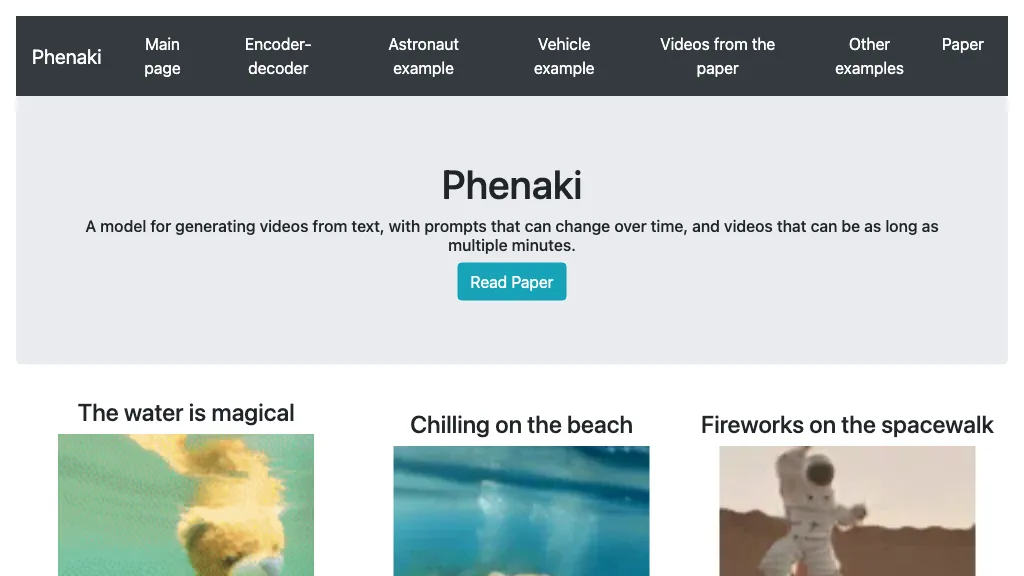What Is Phenaki?
Phenaki is an up-to-date, top-notch AI model for generating realistic videos from textual prompts. Powered by a new class of causal model, Phenaki learns video representations and tokens compressing the same into a series of lifelong learning representations above discrete tokens to easily be able to fine-tune composition length video. That way, Phenaki surpasses the old baselines by a huge margin, making it a groundbreaker in this domain of video generation using AI. The ability of the tool to generate videos with few video-text examples was hinged on large scale image-text copora. This is the first time a video generation methodology of such sort has been investigated in academic research.
Key Characteristics and Advantages of Phenaki
Features and benefits of Phenaki serve large demography users, which makes it one of the most demanded tools in AI for video creation. Some of its salient features are:
-
Creates realistic videos:
Phenaki is able to create photo-realistic videos which look like the real environment from the textual input. -
Causal model to video representation:
It learns a specific causal model to properly understand and learn video representations. -
Video compression into discrete tokens:
Phenaki compresses video content into discrete tokens that help optimize storage and processing efficiency during run time. -
Better performance:
It can exceed the performance level of the traditional per-frame baselines when the task is to produce quality and coherent videos. -
Less number of examples:
The model requires less number of video-text examples to work. Therefore, in this case, Phenaki is highly efficient.
Use Cases and Applications of Phenaki
Pheanki is versatile enough to be deployed across different domains and serves many purposes, making it relevant. Here’s a list sampling some of the areas to which Phenaki can be put to use:
-
Create video content from text scripts:
This will be well-utilized by moviemakers, content creators, who would like to develop their scripts into real video materials. -
Create personalized video messages:
This suitably applies to the marketing team that has to go through the generation of personalized video messages that have to reach the clients. -
Automate and streamline video production to marketing campaigns:
Phenaki automates and enhances the video production process, making it faster and more effective.
Pheanki serves content makers, filmmakers, digital artists, marketing teams, animators, and video editors.
How to Use Phenaki
Using Phenaki requires the following steps:
-
Input textual prompts:
Provide the textual descriptions or prompts you want to turn into a video. -
Build settings:
Change settings and parameters for optimal configuration to the video output requirements. -
Create video:
This allows the video generation process. Phenaki generates any realistic video from the prompts. -
Review / Edit:
You review video output and implement edits otherwise.
Always make sure to create clear and detailed textual prompts so that Phenaki can best create realistic and accurate videos.
How Phenaki Works
Pheanki functions on the basis of sophisticated technical functionality, using a new causal model for video representation. It has just learned how to make an interpretation and generate video sequences by compressing them into discrete tokens using this model. Here’s how:
-
Learning of Video Representations:
The causal information in the video data builds up with which the model learns and produces a representation regarding the gist of the sequence. -
Compression:
The video data is compressed into tokens, which are discrete, and this allows ease in processing and storage. -
Generation:
Based on the learned representations and tokens, Phenaki can generate videos that are realistic while following prescribed textual prompts.
Pros and Cons of Phenaki
Just like other tools available in the market, Phenaki has its pros and cons, which are stated below:
Pros
-
High-Quality Output:
It produces lifelike and seamless videos. -
Efficiency:
It needs fewer examples of the video-text, and thus, less resource-intensive. -
Most Current Technology:
A new causal model is adopted for more efficiency.
Potential Limitations
-
Learning Curve:
One has to familiarize oneself with the tool and the relevant settings to apply it. -
Dependence on the Text Prompts:
Output quality is as good as the textual prompt.
User feedback generally suggests that with the tool, videos can be made of high quality efficiently. However, users do point out the tool is quite hard to master.
Conclusion about Phenaki
To summarize, it is a new breakthrough in an AI video-generation tool which will contain high-quality output and efficient processing. Therefore, having a unique causal model that works with a minimum of video-text examples is really what sets it apart from other innovations of its kind and makes it so invaluable to most industries. Learning to use it is a bit challenging, but its benefits outshine the negatives. In the future, with new developments and updates, it’s only going to get better.
FAQs on Phenaki
Here are some frequently asked questions in relation to Phenaki:
-
Does Phenaki generate video from any type of text prompt?
Phenaki has been designed for video creation using different types of textual prompts. -
Is Phenaki meant for professional video tape production?
Certainly, with high quality and high efficiency design considerations built in, Phenaki can be used professionally where videos have to be created and latterly used in content production. -
What kind of industries do benefit from Phenaki use?
This will help the industries linked to marketing, production, and digital art, including animation, by a large extent. -
What are some of the limitations in using Phenaki?
Though it has quite a few plus points, there definitely is a learning curve while using Phenaki, and its output quality is as good as the quality of the textual prompt given.










